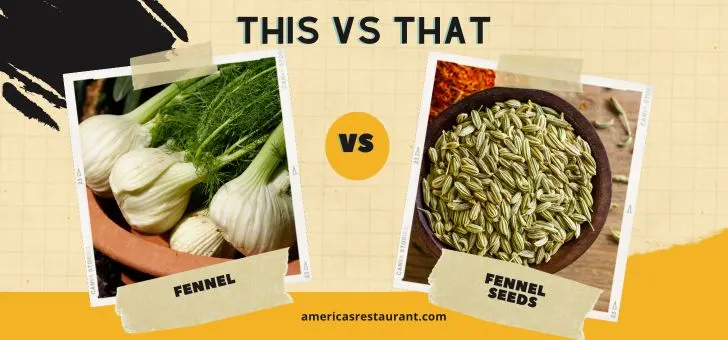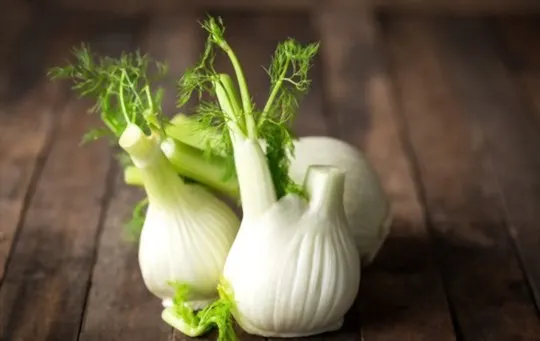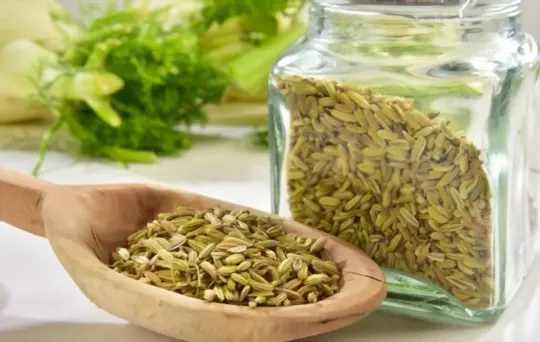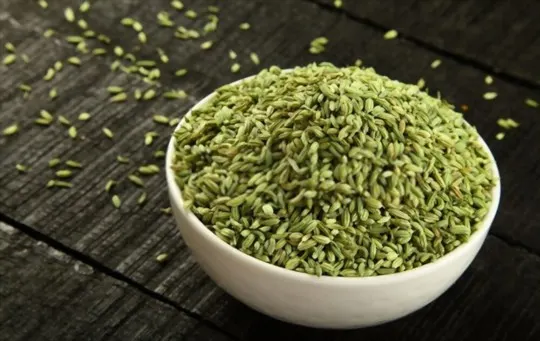Ever found yourself staring at fennel and its seeds, wondering what’s what? We’ve been there.
Fennel, that crunchy, slightly sweet veg, steals the spotlight in many dishes. Meanwhile, its seeds, those little flavor bombs, aren’t just for decoration. They pack a punch in the taste department.
Our kitchens have seen battles. Fennel bulb vs. seed – it’s a story we all know too well. Our verdict? Both have their moments of glory.
Short. Sweet. To the point. That’s how we like it.

What is Fennel?

Fennel, a flowering plant, is a vegetable that belongs to the carrot family.
It has a bulb-like base with green stalks rising from it.
The seeds of this plant are commonly used as a spice in various cuisines worldwide.
Fennel seeds and the bulb are both used for their flavor and medicinal properties.
The sweet aroma of fennel comes from an organic compound known as anethole, which has various health benefits like anti-inflammatory and antioxidant properties.
What are Fennel Seeds?

Fennel seeds are the dried seeds of fennel plants, utilized as a seasoning.
With anise-like taste and aroma, these small, oval-shaped seeds provide a crunchy texture when added whole or ground into dishes.
They have been a part of traditional medicine for their digestive health benefits.
Additionally, the oil extracted from these seeds is used in many industries such as perfumes, soaps, and cosmetics.
When it comes to culinary use, fennel seeds can be used in various ways such as seasoning meat dishes, flavoring bakery items, or enhancing pickles.
Ground fennel seed is also an ingredient in some spice blends such as curry powder or Chinese five-spice powder.
Fennel seed tea is quite popular due to its potential to aid digestion and reduce bloating.
Brewing fennel seed tea can be done by steeping a teaspoon of crushed fennel seeds in boiling water for 10 minutes.
Differences Between Fennel and Fennel Seeds

The properties of fennel and fennel seeds are often compared, giving rise to confusion regarding their individual benefits.
The variations between the two lie in the casing, chemical composition, and usage.
Fennel, a herb belonging to the Apiaceae family, is recognised for its green leaves, bulb-like stem and potent aroma.
On the other hand, fennel seeds are small dried fruit from the same plant with a licorice-like flavour.
While both have unique medicinal properties like aiding digestion and alleviating inflammation, fennel seeds are more commonly used as a spice in Indian cooking.
Meanwhile, fresh or dried Fennel is primarily employed for its flavoursome characteristics in cuisines globally.
What sets them apart is their essential oil content; Fennel Seeds have trans-anethole that gives anise-like notes while essential oils from Fennel Bulbs contain methyl chavicol and fenchone compounds.
Overall, despite their similarities originating from a single core plant species – they hold different culinary purposes based on characteristic distinctions.
Appearance and Form
Fennel comes in two forms: the bulb and the seed.
Both have distinct appearances and forms that determine their uses.
The fennel bulb resembles celery with a white or pale green color, while the seed is small, oblong-shaped, and brownish-green.
The bulb is used as a vegetable for cooking, while the seed is used as a spice in various cuisines and in making teas.
Understanding the difference between these two forms of fennel is crucial when using them in recipes or for medicinal purposes.
Fennel bulbs are typically used to provide a crunchy texture or mild licorice flavor to dishes such as salads, stews, or soups.
The leaves can also be used as a garnish or added to dressings for an extra boost of flavor.
On the other hand, fennel seeds have a warm sweet taste with a subtle anise-like scent that makes them ideal for baking bread, cookies, and cakes.
They can also be ground into powder form and added to savory dishes like curries, sauces, or marinades.
It’s important to note that although both forms have similar flavors and nutritional value, they cannot be substituted for each other due to their differences in appearance and use.
When choosing which form of fennel to use in your recipe or medication mixtures, it’s essential to consider factors such as texture, aroma, taste profile, and intended use.
Flavor and Aroma
The distinctive Flavor and Aroma of fennel and fennel seeds are the primary sources of their appeal in cooking and health.
The flavor of the fennel bulb evokes an anise-like sweetness similar to licorice, with a slightly earthy and grassy undertone.
Fennel seeds are more concentrated than the bulb, giving off a stronger aroma and flavor.
They have a rich combination of sweet and savory notes that are slightly bitter.
Both variations’ taste can complement soups, stews, salads, marinades, roasts, baked goods, blends, teas, oils and other recipes.
Fennel bulbs are widely used in Mediterranean cuisine for their flavor’s sweet anise-like essence.
They go particularly well with seafood dishes such as fish or shellfish; they also blend well with chicken or pork when roasted or grilled.
Fennel seeds’ robust aroma and taste make them suitable for cooking liqueurs such as absinthe or pastis.
Moreover, Fennel seed oil is often used for its unique qualities as it helps freshen breaths after meals and may contribute to general wellness thanks to its anti-fungal properties.
Overall both versions of fennels come from the same plant varieties but have distinct taste features that separate them in cooking.
They both offer unique advantages to one’s palate and health.
Culinary Uses
Fennel and fennel seed are both essential ingredients in cooking and have various culinary uses.
Fennel seeds are commonly used as a seasoning for savory dishes, while fennel bulbs can be eaten raw or cooked in dishes such as salads, soups, and stews.
The anise-like flavor of fennel adds a unique taste to dishes and is a popular choice for Italian, Mediterranean, and Indian cuisine.
When using fennel seeds in cooking, they should be toasted first to release their flavor before being added to the dish.
They can also be ground into a powder and used as a spice rub for meats or added to marinades, dressings, or sauces.
Alternatively, the seeds can be steeped in hot water for tea or added to baking recipes such as bread or cookies.
On the other hand, fennel bulbs have a mild licorice taste that pairs well with fish and seafood dishes.
The bulb can be sliced thin and added to salads or grilled with olive oil and herbs.
Roasted fennel is also a popular side dish that can accompany roasted meat or poultry.
Overall, while both fennel and fennel seed may seem interchangeable in recipes, they each offer unique flavors and culinary uses that cannot be substituted entirely by one another.
Knowing their individual uses will help you elevate your cooking skills and create flavorful dishes that will impress your guests.
Health Benefits
Fennel and fennel seed are two forms of the same plant, and both offer various health benefits.
Fennel has been used for centuries for its medicinal properties, while fennel seeds have essential oils that provide therapeutic and nutritional values.
- Fiber-rich Fennel aids digestion and helps in weight loss.
- The plant has potent antioxidants that help fight inflammation, reducing the risk of chronic diseases.
- It is also known to regulate blood pressure besides being low on calories.
- Fennel seeds enhance nutrient absorption, maintain heart health & are a natural remedy for menstrual pain.
- The oil extracted from the seeds is effective in improving respiratory conditions like coughs and bronchitis.
Apart from these benefits of fennels and their seeds, studies suggest that the herb may have anti-bacterial properties against common strains.
These should be used as complementary food herbs with other medication if any health condition persists.
Understanding the benefits and differences between fennel and its seeds can help make an informed decision about which one to use.
These natural remedies have been traditionally used around the world to improve human health, but it’s best to seek professional advice on consumption quantities of these herbs before including them in daily life.
Similarities Between Fennel and Fennel Seeds

Fennel and fennel seeds share many similarities, making it easy to confuse the two.
Both are part of the same plant, Foeniculum vulgare, and have a licorice-like flavor.
They are commonly used in culinary applications, as well as for medicinal purposes.
Additionally, both contain antioxidants and are rich in vitamins and minerals such as calcium, magnesium, iron and vitamin C.
When it comes to their nutritional value, fennel and fennel seeds offer many of the same benefits.
They are both sources of dietary fiber that can aid in digestion and promote regularity.
Their high levels of vitamin C can also support immune system function.
Despite their similarities, there are some differences between fennel bulb and fennel seeds worth noting.
The bulb is a great source of potassium while the seeds contain important essential oils like anethole that gives it distinctive aroma/flavor.
How to Use Fennel and Fennel Seeds in Cooking?
Fennel and fennel seeds are both essential ingredients in many cuisines.
Knowing how to use them can make a huge difference in the taste of your dishes.
Here are some ways to incorporate fennel and fennel seeds into your cooking:
- Use fresh fennel as a vegetable: Thinly slice or dice fresh fennel and toss it with other vegetables in a salad, roast it in the oven with carrots, potatoes or other root vegetables, or braise it with fish or chicken.
- Use fennel fronds for garnish: The feathery leaves of fresh fennel have a delicate anise flavor that makes an excellent garnish for seafood dishes, pasta, soups or salads.
- Grind fennel seeds: Add ground fennel seeds to dry rubs for meat, sauces for pasta, soups, stews or stir-fries to give them an intense flavor. You can also mix crushed fennel seeds with salt and pepper to create a seasoning blend.
- Toasted Fennel Seeds: Toasting the whole fennel seed lightly will enhance its nutty aroma before grinding it for organic homemade spice blends.
- Infuse Oil and Vinegar: Steep freshly smashed seeds into olive oil or vinegar to make dressings.
Focusing particularly on unique details about using these ingredients – Adding crushed toasted Fennell in food preparations not only gives it an aroma but also enhances the texture of foods.
Availability and Storage
Fennel and fennel seed are readily available in various forms, including whole seeds, ground powder, fresh bulbs, and even supplements derived from the seeds.
Proper storage is important to preserve their aroma and flavor.
It is recommended to keep the dried seeds in an airtight container away from heat and moisture.
Fresh fennel should be used within a few days if possible or refrigerated for up to one week.
In addition, it is important to note that not all grocery stores may carry fresh fennel or high-quality fennel products such as essential oils or supplements.
Be sure to source them from reputable retailers or online vendors to ensure quality and purity.
Conclusion
Comparing Fennel and Fennel Seed, it can be concluded that both have their own unique properties and benefits.
While fennel is a vegetable that can be eaten raw or cooked, fennel seed is commonly used as a spice in cooking.
Fennel has a milder taste compared to the more intense flavor of fennel seeds.
Overall, whether to choose fennel or fennel seeds depends on what you want to achieve with their consumption.
If you’re looking for a flavorful spice that offers health benefits at the same time, then opt for fennel seeds.
On the other hand, if you’re searching for an ingredient that provides nutritional value and adds a subtle flavor to your dish without overpowering it, then go for fresh fennels.

Leave a comment